About Blood
Blood
Blood

Blood is an important fluid that keeps us alive. Amount of blood in your body depends on your size, weight and altitude at which you live. An adult who weight 80 kg has about 4.5 to 6 liters of blood, a 40 kg child, about half the amount. People who live in high area where the air is thinner need more blood to deliver more oxygen to the body. This essential fluid carries out the critical functions of transporting oxygen and nutrients to our cells and getting rid of carbon dioxide, ammonia and other waste products. In addition, it plays a vital role in our immune system and in maintaining a relatively constant body temperature. Blood is a highly specialized tissue composed of more than 4,000 different kinds of components. Four of the most important ones are Plasma, Red cells, White cells and Platelets.
Plasma
Plasma

Plasma is produced in liver and it is pale-yellow liquid component of blood that normally holds the blood cells in whole blood in suspension; makes up about 55% of the body's total blood volume. It is mostly water (up to 95%), and contains dissolved proteins (albumins, globulins and fibrinogen), glucose, clotting factor, electrolytes, hormones, lipids, vitamins, minerals, enzymes, antibody and carbon dioxide.
It plays a vital role in an intravascular osmotic effect that keeps electrolytes in balanced form and protects the body from infection and other blood disorders.
Cells
Cells

White cells, Red cells and Platelets are made in the bone marrow - a jellylike substance that fills the cavities of bones. Bone marrow consists of fat, blood and special cells (stem cells) that turn into the various kinds of blood cells.
Blood cells in babies and very young children are made in the bone marrow of most of the bones in the body. As we get older, some of the bone marrow converts to yellow marrow and just the bones that make up the spine (vertebrae), ribs, pelvis, skull and sternum contain red marrow.
Red cells or erythrocytes
Red cells or erythrocytes

Red cells are relatively large microscopic cells without nuclei. Red cells normally make up 40-50% of the total blood volume. They transport oxygen from the lungs to all of the living tissues of the body and carry away carbon dioxide. The red cells are produced continuously Stem Cells at a rate of about 2-3 million cells per second. Hemoglobin is the gas transporting protein molecule that makes up 95% of a red cell. Each red cell has about 270,000,000 iron-rich hemoglobin molecules. People who are anemic generally have a deficiency in red cells, and subsequently feel fatigued due to a shortage of oxygen. The red color of blood is primarily due to oxygenated red cells. Human fetal hemoglobin molecules differ from those produced by adults in the number of amino acid chains. Fetal hemoglobin has three chains, while adults produce only two. As a consequence, fetal hemoglobin molecules attract and transport relatively more oxygen to the cells of the body.
White Cells or leukocytes
White Cells or leukocytes

White cells are existing in variable numbers and types but make up a very small part of blood's volume normally only about 1% in healthy people. Leukocytes are not limited to blood. They occur elsewhere in the body as well, most notably in the spleen, liver, and lymph glands. Most are produced in our bone marrow from the same kind of stem cells that produce red blood cells. Others are produced in the thymus gland, which is at the base of the neck. Some white cells (called lymphocytes) are the first responders for our immune system. They seek out, identify, and bind to alien protein on Bacteria, Viruses and Fungi so that they can be removed. Other white cells (called granulocytes and macrophages) then arrive to surround and destroy the alien cells. They also have the function of getting rid of dead or dying blood cells as well as foreign matter such as dust and asbestos. Red cells remain viable for only about 4 months before they are removed from the blood and their components recycled in the spleen. Individual white cells usually only last 18-36 hours before they also are removed, though some types live as much as a year. The description of white cells presented here is a simplification. There are actually many specialized sub-types of them that participate in different ways in our immune responses.
Platelets or Thrombocytes
Platelets or Thrombocytes

Platelets are cell fragments without nuclei that work with blood clotting chemicals at the site of wounds. They do this by adhering to the walls of blood vessels, thereby plugging the rupture in the vascular wall. They also can release coagulating chemicals which cause clots to form in the blood that can plug up narrowed blood vessels. Thirteen different blood clotting factors, in addition to platelets, need to interact for clotting to occur. They do so in a cascading manner, one factor triggering another. Hemophiliacs lack the ability to produce either blood factor 8 or 9. Platelets are not equally effective in clotting blood throughout the entire day. The body's circadian rhythm system (its internal biological clock) causes the peak of platelet activation in the morning. This is one of the main reasons that strokes and heart attacks are more common in the morning. Recent research has shown that platelets also help fight infections by releasing proteins that kill invading bacteria and some other microorganisms. In addition, platelets stimulate the immune system. Individual platelets are about 1/3 the size of red cells. They have a lifespan of 9-10 days. Like the red and white blood cells, platelets are produced in bone marrow from stem cells.